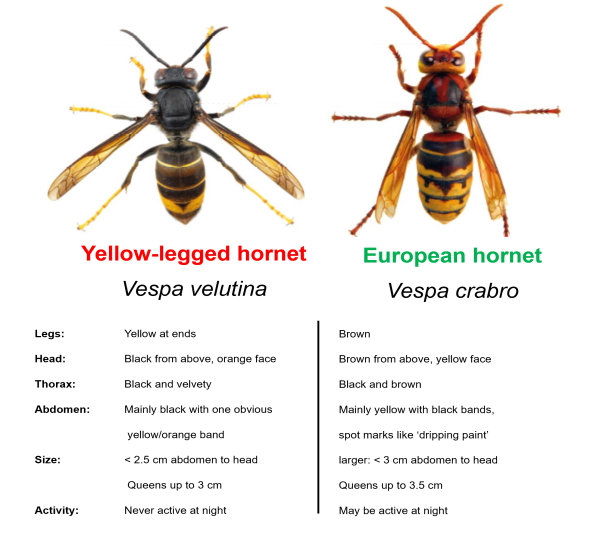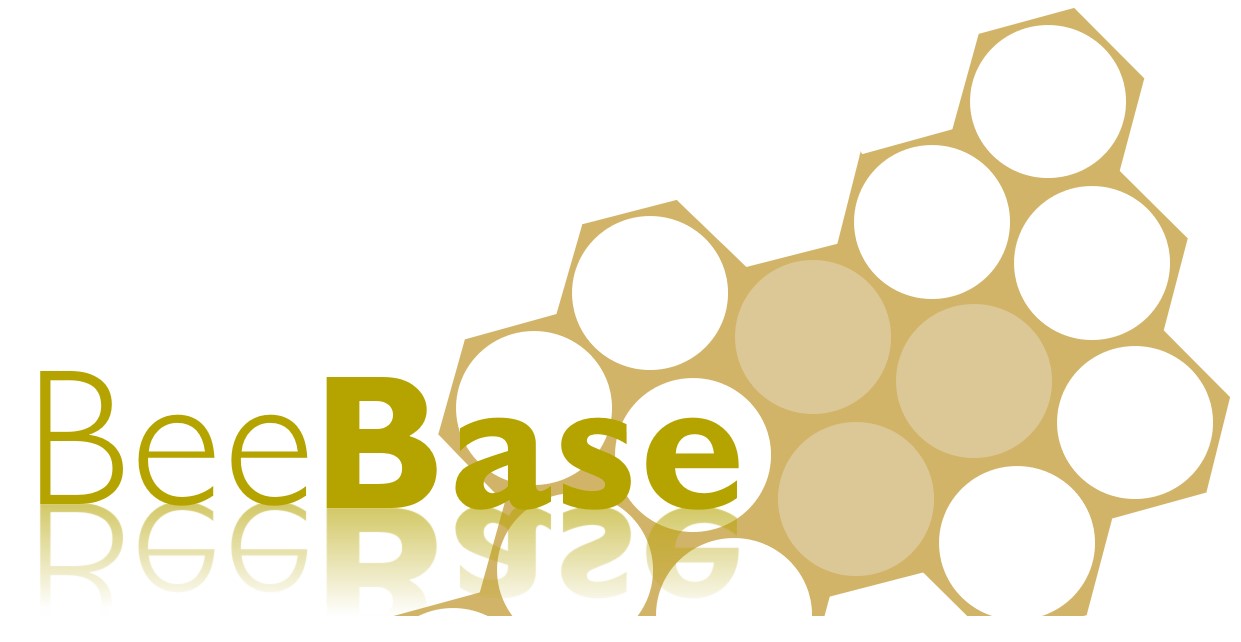Find out on this page how to:
• Identify the yellow-legged hornet
• Report suspect sightings of the yellow-legged hornet
• Take a photo of a suspect insect safely
• Send a suspect yellow-legged hornet sample to the lab for identification
Every year, we receive thousands of reports of suspected yellow-legged hornets, but the vast majority of sightings are of native insects. Please review the identification guidance before submitting a report.
How to identify a yellow-legged hornet
Contrary to popular belief, the invasive yellow-legged hornet (previously referred to as the Asian hornet) is not a large insect and is smaller than the European hornet, which is native to the UK. European hornets are yellow and brown, they are very large and make a loud sound when they fly. Yellow-legged hornets are more similar in size to wasps, but are much darker in colour than any native wasp. The image below shows the invasive yellow-legged hornet on the left and the native European hornet on the right.

There are many other common insects that may be mistaken for the yellow-legged hornet. The Non Native Species Secretariat has prepared an ID Sheet that has photos of other insects commonly misidentified as the yellow-legged hornet. The Asian Hornet Watch app also contains photos of similar species. If you’re not sure which insect you’ve seen, please take a photo and report it, or discuss it with your local Asian Hornet Team (AHT). Find out where your closest AHT is using the BBKA Asian Hornet Team website. To learn more about AHTs, please visit our page on the role of Asian Hornet Teams.
How to report a yellow-legged hornet
If you believe you have seen a yellow-legged hornet, please report it. You can report your sighting by:
• Using the Asian Hornet Watch app for iPhone or app for android
• Filling in the online recording form
• Emailing alertnonnative@ceh.ac.uk
If you do not have a photo of your sighting or use of a smart phone, or need any kind of assistance reporting a sighting, you can contact your local Asian Hornet Team (AHT).
How to take a photograph safely
We can only follow up sightings when a clear photo of the suspect insect has been provided. You are likely to find it easier to take a photo of an insect when it is occupied, for example, feeding on a sugary bait in a monitoring station, or on fallen fruit. Images need to be clear and in focus in order to identify markings on the body and enable identification.

A simple monitoring station can be constructed using a tray or saucer with a small amount of sugary fruit juice or wasp bait in the bottom. To prevent insects from drowning, place kitchen towel in the tray to soak up the liquid, or small items that insects can stand on to drink the bait. Ensure the tray is weighed down to prevent it from being blown over; a few small rocks should suffice. While the insects are feeding, they will be less active, enabling clear photos to be taken. If using a lidded tray, keep the lid nearby so that if you notice a suspicious insect, you can quickly trap the insect inside by sealing the lid. The images above, kindly provided by Ian Nichols, demonstrate some different styles of monitoring stations. For more information on how to construct a monitoring station to attract insects, please read the Yellow-legged hornet monitoring fact sheet. Please do not use traps that kill insects.
Please take care and remain calm when photographing hornets. Do not under any circumstances disturb or provoke an active nest.
Sending a hornet sample
If you have trapped a suspect insect, please keep it, if it is safe to do so. If the hornet is not dead, you can place it in a freezer for 24 hours so that it can be handled safely. Please report the sample using one of the methods above. If you report a hornet and have a sample, we can arrange to pick the sample up.
If you are asked to send a sample, please make sure it is dead and then package it in a sturdy, breathable (e.g. cardboard) container. Do not place it unprotected in an envelope, as it may be squashed, which hinders identification. Provide as much detail as possible about the sample, such as when and where it was found and your contact details using our voluntary sample submission form. Please contact us if you would like a prepaid label.
Please send the sample to:
Bee Health Laboratory, Lab 02G06, York Biotech Campus, Sand Hutton, York, YO41 1LZ.
Further information:
For up-to-date information on yellow-legged hornet sightings in the UK, please read our 2024 Rolling update page. For sightings and nests found in previous years, please visit the Defra webpage, Yellow-legged hornet sightings recorded since 2016.
This 2021 BeeCraft article gives a helpful guide to differentiating between invasive yellow-legged hornets and native insects which are commonly mistaken for it: Asian hornet identity parade.
This information sheet produced by The Bees, Wasps & Ants Recording Society (BWARS) provides an overview of the native European hornet: BWARS Information sheet on the European hornet, Vespa crabro.
